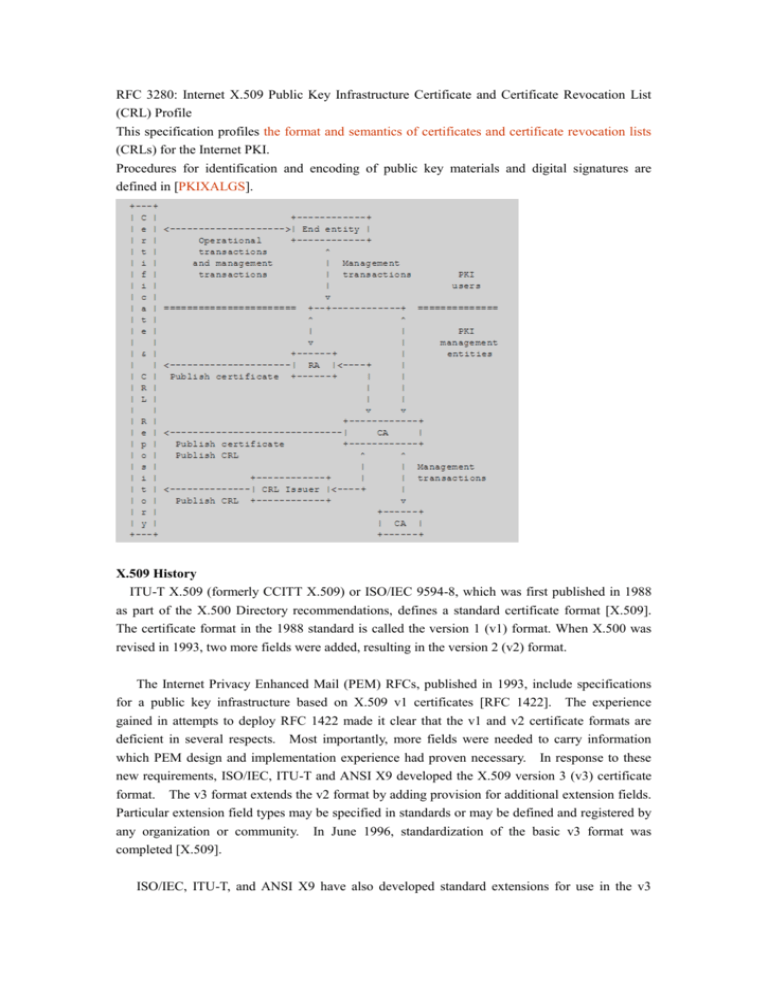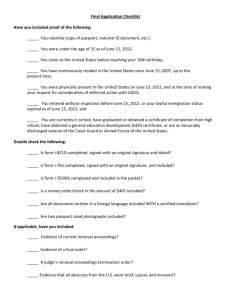RFC 3280: Internet X.509 Public Key Infrastructure Certificate and
advertisement

RFC 3280: Internet X.509 Public Key Infrastructure Certificate and Certificate Revocation List
(CRL) Profile
This specification profiles the format and semantics of certificates and certificate revocation lists
(CRLs) for the Internet PKI.
Procedures for identification and encoding of public key materials and digital signatures are
defined in [PKIXALGS].
X.509 History
ITU-T X.509 (formerly CCITT X.509) or ISO/IEC 9594-8, which was first published in 1988
as part of the X.500 Directory recommendations, defines a standard certificate format [X.509].
The certificate format in the 1988 standard is called the version 1 (v1) format. When X.500 was
revised in 1993, two more fields were added, resulting in the version 2 (v2) format.
The Internet Privacy Enhanced Mail (PEM) RFCs, published in 1993, include specifications
for a public key infrastructure based on X.509 v1 certificates [RFC 1422]. The experience
gained in attempts to deploy RFC 1422 made it clear that the v1 and v2 certificate formats are
deficient in several respects. Most importantly, more fields were needed to carry information
which PEM design and implementation experience had proven necessary. In response to these
new requirements, ISO/IEC, ITU-T and ANSI X9 developed the X.509 version 3 (v3) certificate
format. The v3 format extends the v2 format by adding provision for additional extension fields.
Particular extension field types may be specified in standards or may be defined and registered by
any organization or community. In June 1996, standardization of the basic v3 format was
completed [X.509].
ISO/IEC, ITU-T, and ANSI X9 have also developed standard extensions for use in the v3
extensions field [X.509][X9.55]. These extensions can convey such data as additional subject
identification information, key attribute information, policy information, and certification path
constraints.
However, the ISO/IEC, ITU-T, and ANSI X9 standard extensions are very broad in their
applicability. In order to develop interoperable implementations of X.509 v3 systems for Internet
use, it is necessary to specify a profile for use of the X.509 v3 extensions tailored for the Internet.
It is one goal of this document to specify a profile for Internet WWW, electronic mail, and IPsec
applications. Environments with additional requirements may build on this profile or may replace
it.
Format
The X.509 v3 certificate basic syntax is as follows. For signature calculation, the data that is to
be signed is encoded using the ASN.1 distinguished encoding rules (DER) [X.690]. ASN.1 DER
encoding is a tag, length, value encoding system for each element.
Syntax:
Certificate ::= SEQUENCE {
tbsCertificate
TBSCertificate,
signatureAlgorithm AlgorithmIdentifier,
signatureValue
BIT STRING }
TBSCertificate ::= SEQUENCE {
version
[0] EXPLICIT Version DEFAULT v1,
serialNumber
CertificateSerialNumber,
signature
AlgorithmIdentifier,
issuer
Name,
validity
Validity,
subject
Name,
subjectPublicKeyInfo SubjectPublicKeyInfo,
issuerUniqueID [1] IMPLICIT UniqueIdentifier OPTIONAL,
-- If present, version MUST be v2 or v3
subjectUniqueID [2] IMPLICIT UniqueIdentifier OPTIONAL,
-- If present, version MUST be v2 or v3
extensions
[3] EXPLICIT Extensions OPTIONAL
-- If present, version MUST be v3
}
Version ::=
INTEGER { v1(0), v2(1), v3(2) }
CertificateSerialNumber ::=
INTEGER
Validity ::= SEQUENCE {
// Both notBefore and notAfter may be encoded as UTCTime
or GeneralizedTime.
notBefore
Time,
notAfter
Time ::= CHOICE {
utcTime
generalTime
Time }
UTCTime,
GeneralizedTime }
UniqueIdentifier ::= BIT STRING
SubjectPublicKeyInfo ::=
algorithm
subjectPublicKey
SEQUENCE {
AlgorithmIdentifier,
BIT STRING }
Extensions ::= SEQUENCE SIZE (1..MAX) OF Extension
Extension ::= SEQUENCE {
extnID
OBJECT IDENTIFIER,
critical
BOOLEAN DEFAULT FALSE,
extnValue OCTET STRING }
Three main parts:
tbsCertificate
The field contains the names of the subject and issuer, a public key associated with the subject,
a validity period, and other associated information. The fields are described in detail in section
4.1.2; the tbsCertificate usually includes extensions which are described in section 4.2.
signatureAlgorithm
The signatureAlgorithm field contains the identifier for the cryptographic algorithm used by
the CA to sign this certificate.[PKIXALGS] lists supported signature algorithms, but other
signature algorithms MAY also be supported.
An algorithm identifier is defined by the following ASN.1 structure:
AlgorithmIdentifier ::= SEQUENCE {
algorithm
OBJECT IDENTIFIER,
parameters
ANY DEFINED BY algorithm OPTIONAL }
The algorithm identifier is used to identify a cryptographic algorithm. The OBJECT
IDENTIFIER component identifies the algorithm (such as DSA with SHA-1). The contents of
the optional parameters field will vary according to the algorithm identified.
This field MUST contain the same algorithm identifier as the signature field in the sequence
tbsCertificate (section 4.1.2.3).
signatureValue
The signatureValue field contains a digital signature computed upon the ASN.1 DER encoded
tbsCertificate. The ASN.1 DER encoded tbsCertificate is used as the input to the signature
function. This signature value is encoded as a BIT STRING and included in the signature field.
The details of this process are specified for each of algorithms listed in [PKIXALGS].
By generating this signature, a CA certifies the validity of the information in the tbsCertificate
field. In particular, the CA certifies the binding between the public key material and the subject
of the certificate.
Sample Certificate:
Data:
Version: 3 (0x2)
Serial Number: 1 (0x1)
Signature Algorithm: md5WithRSAEncryption
Issuer: C=ZA, ST=Western Cape, L=Cape Town, O=Thawte Consulting cc,
OU=Certification Services Division,
CN=Thawte Server CA/emailAddress=server-certs@thawte.com
Validity
Not Before: Aug 1 00:00:00 1996 GMT
Not After : Dec 31 23:59:59 2020 GMT
Subject: C=ZA, ST=Western Cape, L=Cape Town, O=Thawte Consulting cc,
OU=Certification Services Division,
CN=Thawte Server CA/emailAddress=server-certs@thawte.com
Subject Public Key Info:
Public Key Algorithm: rsaEncryption
RSA Public Key: (1024 bit)
Modulus (1024 bit):
00:d3:a4:50:6e:c8:ff:56:6b:e6:cf:5d:b6:ea:0c:
68:75:47:a2:aa:c2:da:84:25:fc:a8:f4:47:51:da:
85:b5:20:74:94:86:1e:0f:75:c9:e9:08:61:f5:06:
6d:30:6e:15:19:02:e9:52:c0:62:db:4d:99:9e:e2:
6a:0c:44:38:cd:fe:be:e3:64:09:70:c5:fe:b1:6b:
29:b6:2f:49:c8:3b:d4:27:04:25:10:97:2f:e7:90:
6d:c0:28:42:99:d7:4c:43:de:c3:f5:21:6d:54:9f:
5d:c3:58:e1:c0:e4:d9:5b:b0:b8:dc:b4:7b:df:36:
3a:c2:b5:66:22:12:d6:87:0d
Exponent: 65537 (0x10001)
X509v3 extensions:
X509v3 Basic Constraints: critical
CA:TRUE
Signature Algorithm: md5WithRSAEncryption
07:fa:4c:69:5c:fb:95:cc:46:ee:85:83:4d:21:30:8e:ca:d9:
a8:6f:49:1a:e6:da:51:e3:60:70:6c:84:61:11:a1:1a:c8:48:
3e:59:43:7d:4f:95:3d:a1:8b:b7:0b:62:98:7a:75:8a:dd:88:
4e:4e:9e:40:db:a8:cc:32:74:b9:6f:0d:c6:e3:b3:44:0b:d9:
8a:6f:9a:29:9b:99:18:28:3b:d1:e3:40:28:9a:5a:3c:d5:b5:
e7:20:1b:8b:ca:a4:ab:8d:e9:51:d9:e2:4c:2c:59:a9:da:b9:
b2:75:1b:f6:42:f2:ef:c7:f2:18:f9:89:bc:a3:ff:8a:23:2e:
70:47
Related Signature and Encryption Algorithms
RFC 3279: Algorithms and Identifiers for the Internet X.509 Public Key Infrastructure Certificate
and Certificate Revocation List (CRL) Profile
Updated by
RFC 4491(Using the GOST R 34.10-94, GOST R 34.10-2001, and GOST R 34.11-94
Algorithms with the Internet X.509 Public Key Infrastructure Certificate and CRL Profile)
and RFC 4055(Additional Algorithms and Identifiers for RSA Cryptography for use in the
Internet X.509 Public Key Infrastructure Certificate and Certificate Revocation List (CRL)
Profile).
RFC 3279 --- X.509 related algorithms:
One-Way hash functions:
MD2
MD5
SHA-1
Signature Algorithms:
RSA Signature Algorithm
DSA Signature Algorithm
Elliptic Curve Digital Signature Algorithm
Subject Public Key Algorithms:
RSA keys
DSA Signature Keys
Diffie-Hellman Key Exchange Keys
KEA Public Keys
ECDSA and ECDH Public Keys
RFC 4055 --- RSA Cryptography Algorithms
Common Functions
One-way Hash Functions
Mask Generation Functions
RSASSA-PSS Signature Algorithm
RSASSA-PSS Public Keys
RSASSA-PSS Signature Values
RSASSA-PSS Signature Parameter Validation
RSAES-OAEP Key Transport Algorithm
RSAES-OAEP Public Keys
PKCS #1 Version 1.5 Signature Algorithm








